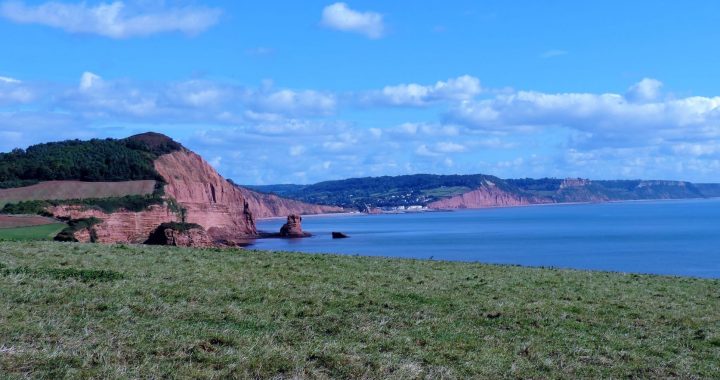We have stayed at a particular cottage in Lympstone a couple of times before. It sets right at the end of a tiny cobbled lane with no vehicle access. The lane opens out into the last couple of houses that look out onto the whole Exe estuary, with Powderham Castle straight ahead across the tidal river, the narrowing channel towards Topsham and Exeter on your right and the wider waters leading to Exmouth and the protective arm of Dawlish Warren to the left. The sun sets directly onto the cottage with its little patio outside and at the flood the water, littered with small boats bobbing at anchor, is lapping only ten feet away but a comfortable distance below the sea wall.
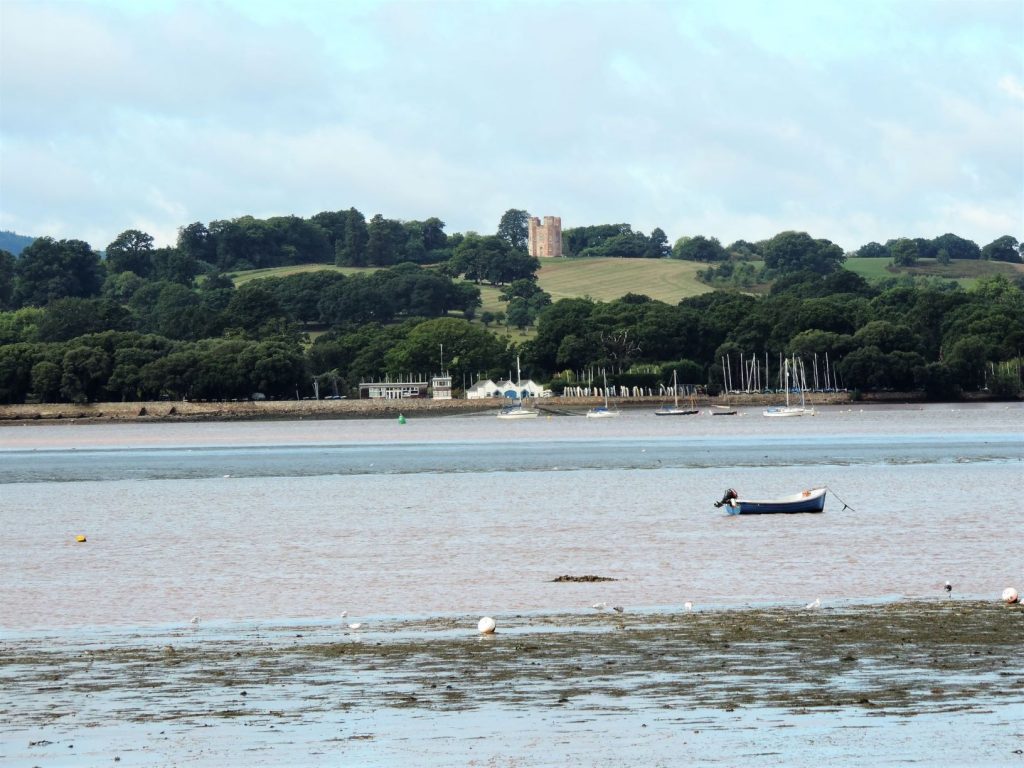
Powderham Castle from the Living Room
We had tried to book this cottage again a couple of years ago only to find that it had been sold and taken off the holiday let market. This year we suddenly noticed that it had come back on, refurbished and refitted and couldn’t resist taking it for a week regardless of all the other upheaval we were involved in.
After a day in Purley running errands, catching up on our admin and the all-important pre-holiday trip to the hairdressers for both of us, we drove down on Friday in blustery sunshine most of the way, with the occasional squally rain shower that would lash down hard out of nowhere, driven by the wind and then stop almost as soon as it had started. The A303 seems to have become even worse since we last used it and the notorious section past Stonehenge and Winterbourne Stoke was a nose to tail crawl for several miles. To be fair to Renault’s SatNav, despite its stubborn French idiosyncrasies it did its job and re-routed us through Langport to the M5 so we didn’t lose too much time overall. We were in Lympstone, hauling our baggage along the cobbled lane before 16:00.
Lympstone and the cottage are just as we remembered but both seem to have had an extra coat of gloss since we last stayed here. We had been through a couple of times since but only on our bikes on the Exe Valley trail. There is a great downhill section down and into the village but a tough uphill climb at the station to get out and on towards the Royal Marine Commando base at Exton; you can’t afford to stop and admire the scenery as you swoop past The Swan at the bottom of the hill. We worked out that it had been seven years since our last proper visit. The Globe Inn has a very different feel, The Swan has upped its game, a teashop has appeared and a lot of the properties have been decorated, renovated or extended in different ways. The cottage has the same basic layout as before but is lighter and brighter inside and has better central heating and excellent internet connection. It is nice to find that, overall, the changes we can see are improvements and have done nothing to spoil the memory.
Saturday was a complete washout, as had been long-predicted. An ideal excuse to laze about the cottage, wander into the big stores we don’t easily have access to on the boat to look at ideas for the house and pick up the bits you always find you have forgotten at the supermarket. What, then, to do on a rainy Saturday afternoon in Exeter? For the second week in a row we found ourselves at the cinema. Largely on the toss of a coin, we went to see “A Simple Favour”. Excellent! It was far better than we had expected. In principle it is a mystery thriller, with the odd knowing nod to Gaslight & Dominique but it was also very funny. We both enjoyed it hugely so I would certainly recommend it and it filled the time nicely for our return to Lympstone, still in the driving rain, for dinner at The Globe. This pub seems to have been taken over and run by a local company called ‘Good Game’. I guess it is part of a diversification strategy based around and original farming business and it is all about the meat and game. Locally sourced from their own pig farm or their neighbours cattle or in the latter case shot in the wild on their own land and served fresh to the table. They had a great selection of real ales but also a range of English lagers such as ‘Sulis’ from Bath Ales, which was as good as any Peroni or San Miguel but perhaps a bit lighter and a lager from Samuel Adams that I have yet to try. It was quite a contrast to what we remember as very much a locals’ spit & sawdust where silence fell as soon as a stranger entered the doors. The only down side is that, of course, they have also adjusted their prices to match.
The miserable weather was forecast to continue through Sunday morning and it seemed to be going that way, which called for a leisurely breakfast, trending into brunch, with all the trimmings. The sea was grey but fairly still first thing but things changed a lot very quickly so that first the wind rose, followed by heavy rain about 08:00, then a steady drizzle and a little calmer. About 11:00 we began to see the odd dog walker on the tideline and we realised it had stopped and small gaps were appearing in the clouds. By noon the sun was out, the wind was light and the sky was mainly blue which was how it stayed for the rest of the day.
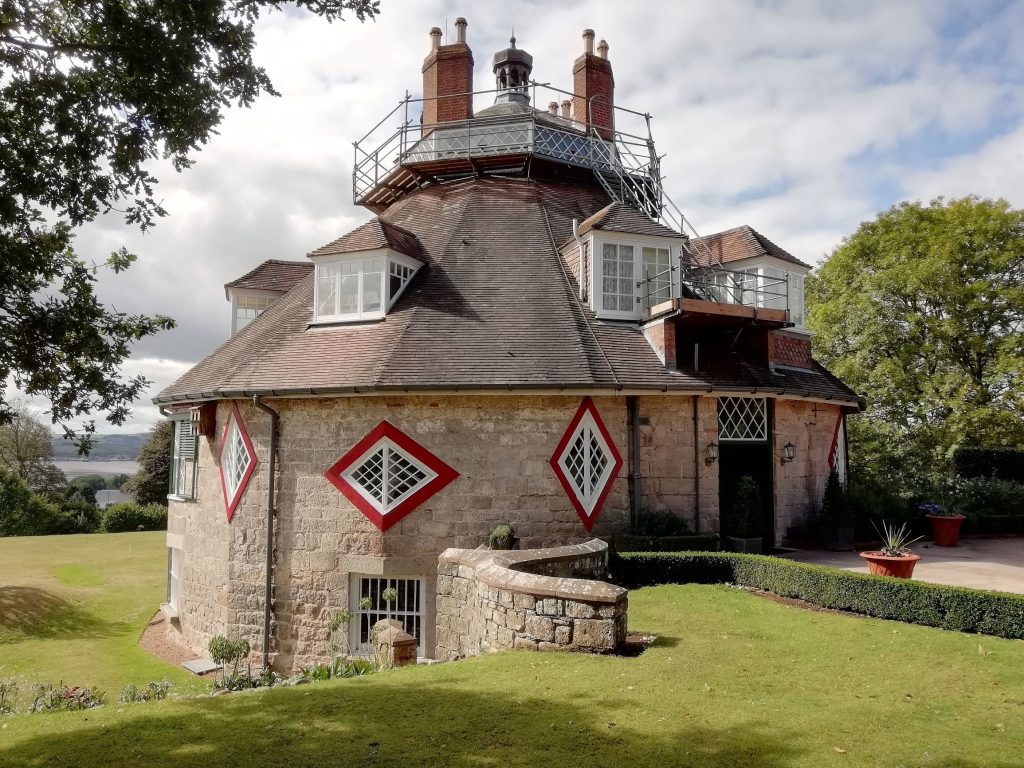
A la Ronde
We went off to have a look at A la Ronde, a National Trust property just a couple of miles away that we had never visited before. A smallish house built in the 18th Century by two ladies following their experiences on the Grand European Tour it is a fascinating property. It was rare, in those times for women to do the tour, as rare as it was for them to own property or mastermind the construction of a building so they were clearly unusual and they were most imaginative. The house is built with 16 sides, designed in such a way as to catch the sun in different rooms as it moves around the property throughout the day. There is something for everybody here. I think Judy Edwards would be fascinated by the huge collection of handicraft items created by the pair, mainly based on shells found locally and the feathers of birds; some found in the field, some taken from the kitchens. The more engineering minded will be hooked by some of the innovations installed by the only male owner of the house and there is even a croquet lawn to captivate Nigel Trotter.

View of the Croquet Lawn from below the Ha-Ha
Much is made of the shell gallery, which can be seen if you follow this link:
https://www.nationaltrust.org.uk/a-la-ronde/features/the-shell-gallery-at-a-la-ronde
but for us the absolute highlight was the stunning panorama presented from the west window of the first floor bedroom. It is a sensational view up and down the estuary and yet the room that provides it was not even part of the original design as only store rooms occupied the upper floor at that time.
Jane Parminter is believed to have been the principal designer of the original property in all its intricate detail, sometimes using local shipwrights, who were skilled at fitting all manner of features into small, oddly shaped spaces just as our boat builders are today. Mary, seventeen years younger and an orphaned second cousin for whom Jane had become guardian, was just as passionate about the house, lived in it for nearly fifty years until her death and established the rules of inheritance that insisted the property only be passed down to an unmarried, female relative. They say that this tradition was only broken once in Victorian times. The truth is this breach lasted forty years and was the period when most of the innovations seen around the property such as central heating, speaking tubes, dumb waiters and the bedroom with the fabulous view were installed.
By the time we left A la Ronde the weather had improved to such an extent that were able to take a walk from the cottage up and out onto the surrounding hills and back into the outskirts from the other side which led us back down to the sea and a walk along the exposed foreshore to the emerge via a small harbour into the centre of the village again in time for a traditional cream tea and another debate about jam or cream first.
On Monday we awoke to a jewel of a morning. The high ground behind the village casts a long shadow first thing and the opposite bank is bathed in sunlight so, at this time of year when the nights have been cold but the rising sun still has the heat in it, you can see the expanding band of sunlight running down the far side of the estuary marked by the mist and steam rising from the surface of the water before it finally burns off an hour or so later. We headed east towards Otterton and took a walk up to the South West Coast Path and then back inland to return along the River Otter for a late lunch at the mill café in Otterton. Views from the coast path were as spectacular as always far out to sea and along the rich, red cliffs of the coastline. The walk back offered equally impressive views inland, over the forests and across the lush green pastures laid out on the flat plan around the river. It’s a shame the camera utterly fails to capture what the eye so readily sees.

View from the Coat Path

The Otter is pretty wide in places but is also generally shallow and unnavigable frequently clamouring for attention with a classic ‘babbling brook’ sound as it rushes over the stones. On the way back down the east bank we came across a specially constructed fish pass. A weir had been built across the river at this point, presumably to manage the water for use at the mill downstream. Apparently the fish couldn’t swim up it to spawn. In 1998 a special stepped ‘pass’ was constructed on one side of the weir that allowed them to make their way past and restored migratory fish runs to the River Otter after an interval of 100 years.

The Fish Pass on the Otter
The weather on Tuesday was every bit as good as Monday and slightly warmer towards the end, it was definitely time to declare an Indian Summer and we spent the day exploring the Killerton Estate. The house was built in the 18th century and the family that owned the estate can be traced back to the 12th century yeoman farmers, steadily increasing in prosperity and prestige through farming, property and marriage. We don’t know much more because every aspect of every room in the house had been overtaken by an exhibition on women’s suffrage. We were aware that there was an exhibition on the topic but had thought it would have a specific space alongside the normal presentation. Instead it absolutely drowned out any other information on the history of both the estate and its owners. We did learn that Sir Richard Acland, having inherited Killerton in 1939, ended up giving the whole 6,400 acre estate with the family home, 20 farms and a watermill over to the National Trust in 1944. What we found striking was that it was not done to avoid tax or duties and not because he couldn’t afford to maintain it but solely on the basis of his own socialist beliefs and the desire to make it available for the enjoyment of all. Quite a gesture!
Under the circumstances we didn’t stay long in the house, preferring to get back out in the sunshine. There is a pleasant walk around the immediate grounds that take you past a number of interesting features. My favourite was the little thatched summer house built for Lady Lydia. This is interesting in itself, being rough-hewn with basketry and hessian ceilings and a floor made up of a mosaic of cobbles, log ends and deer knuckle-bones yet with a separate little ‘hermitage’ room which has a full-on 16th century stained glass window from the Netherlands. On top of that, originally called the Summer Cot it became known, in the 1860’s, as the Bear’s Hut when the 12th Baronet’s brother, Gilbert, brought a Black Bear called Tom back from Canada and housed it there.

The Bears Hut

The Bears Hut Window
Clyston Mill is about 3 miles away near Broadclyst on a route that takes you past the Old Post Office in Budlake. The Trust have dressed this up to exactly represent a Post Office in the 1950’s and it is a bit alarming to find that they regard that as a part of our ancient heritage. When did my childhood become ancient history? It is a good display, though. The national savings stamps for boys and girls and the postal orders caught our eye. It also shows clearly that, despite complaints about Post Office counters moving into W H Smith and Spar shops today, the Post Office was always just one aspect of what was a general store with a very wide range of goods for sale.
By the time we had toured the mill, which is still working and producing flour today on specific days, then explored the mediaeval hall known as Marker’s in Broadclyst village itself and found our way back over to Killerton House we were ready for a refreshing cup of tea back at the cottage, where our daughter Jen was waiting, having come down by train to join us for a couple of days.
Wall to wall sunshine was once again the order of the day on Wednesday. With a young person on board something more adventurous was in order so we booked the three of us in to a Segway tour in Haldon Forest, high up above Exeter on the edge of Dartmoor. This was great fun, as always and the only way to travel. Certainly an all-terrain Segway and the land to use it on are the first things on my shopping list when I win the lottery! If they were ever road legal in the UK I might have to save up for one anyway.

Segway Team
After that excitement we just had time to cross to the other side of the estuary for a circular walk around Woodbury Common, only 5 miles but a lot of up and down with it. The walk took us mostly through heath and woodland and as we went along with the sunlight streaming through the trees it was strongly reminiscent of the woods in Surrey where we used to do our field shooting and made us quite nostalgic to have a bow in hand and a quiver full of arrows ready to be lost. It seems a very long time since we were able to do that and we certainly don’t have room for the gear on the boat.
Thursday was our last day here but it was another day of completely clear blue skies and sunshine. A leisurely visit to a place called Knighthayes Court, another National Trust Property near Tiverton. This one was only late Victorian but had been built in a grand gothic style. The original architect William Burges was famous in his day but had some quite wild and lavish ideas. Apparently he was known to dress up in mediaeval costume and was fond of smoking opium, so a bit of a character. Presumably some of his more elaborate designs were produced under the influence. He was sacked and replaced before it was built but a lot of his designs were used in the final building if a little toned down. Once they moved in the family still found it a bit much and plastered over a lot of the ornate ceilings etc. The Trust have restored one bedroom to the full original Burges design and it gives a good feel for the flights of fancy he pursued.
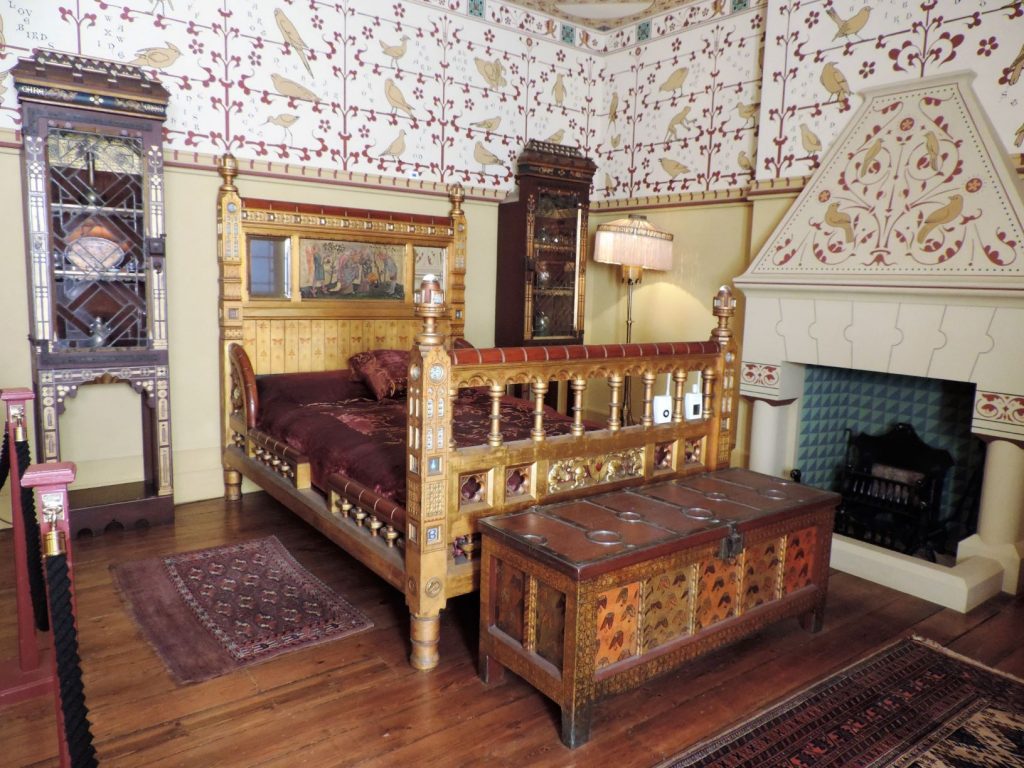
William Burges full-on Master Bedroom Design
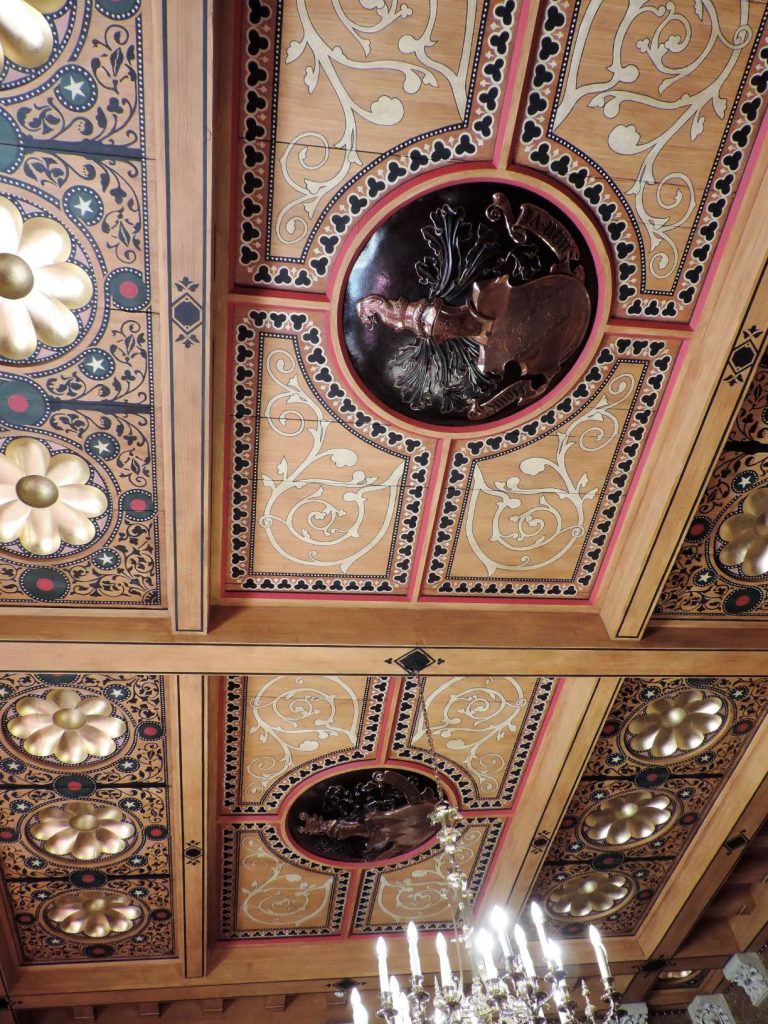
We called in to the Antiques Centre on Topsham Quay on the way back to Lympstone. This is a fascinating collection of all manner of bric-a-brac, antiques and pure tat spread over three floors and always worth a browse. Topsham is a really nice little town on the Exe estuary just north of Lympstone. We had stayed there before and we once considered it a possible retirement destination. Then we saw the amount of development planned around it. A lot of that has now been completed and it is as bad as we feared, with some of the houses just built being quite ugly and completely out of keeping. More importantly there is no way that the sheer numbers of people and cars who will be coming to occupy all of this could ever be accommodated in the narrow streets and limited facilities of the existing town and no scope to change those things without destroying it completely. It made us quite sad to see.
A final tea of jam & cream scones basking in the afternoon sun outside the cottage, a last fantastic evening sunset to watch and a delicious farewell meal at The Swan brought our holiday effectively to an end. A shame to leave this little idyll but a lot to look forward to when we get back to our floating home.

